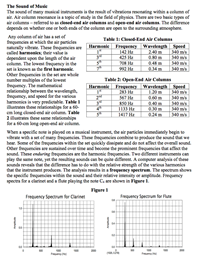 The Sound of Music
The Sound of Music
Resource:
The Science Reasoning Center: The Sound of Music
Grade Level: High School
Description:
This passage uses two tables to compare and contrast the frequency, wavelength and speeds of the various harmonics produced by open- and closed-end resonance columns. The frequency composition of a clarinet and a flute are compared to one another. Questions target a student's ability to select information from a complex data table or a graph, to identify the relationship among the variables wavelength, frequency, speed and harmonic number, to use such relationships to make comparisons of the sounds produced by two different air columns, and to combine information in a table with information in a graph in order to identify appropriate conclusions.
Performance Expectation:
HS-PS4-1 Use mathematical representations to support a claim regarding relationships among the frequency, wavelength, and speed of waves traveling in various media.
This activity aligns with the three dimensions of the Next Generation Science Standards in the manner described below:
| Waves Properties (HS-PS4.A.1): Wavelength and frequency of a wave are related to one another by the speed of travel of the wave, which depends on the type of wave and the medium through which it is passing. |
The sound of many musical instruments is the result of vibrations resonating within a column of air. As the reader of this passage can discover, the wavelength of the sound wave produced is a fraction multiple of the length of the instrument’s air column. Since the fundamental frequency played is equal to the constant speed of sound divided by this wavelength, the longer the instrument the lower the frequency played. Musical instrument, therefore, are a great application of this wavelength, frequency, and wave speed relationship. |
| Patterns: Empirical evidence is needed to identify patterns. |
Mathematical relationships and patterns can be found throughout the study of music and musical instruments. This passage requires students to discover some of these patterns. A question at the close of this passage, for example, asks students to use a pattern that they observe in a data table of frequencies for various harmonics to predict the frequency of a harmonic that is beyond the range of collected data. In addition, as students consider the two frequency spectrum graphs, they will undoubtedly observe the pattern of evenly spaced harmonic frequencies that are present for both open- and closed-ended air columns. |
| Cause and Effect: Systems can be designed to cause a desired effect. |
Piccolos typically play high frequencies while tubas typically play low frequencies. There exists a simple relationship that the frequencies played by an instrument are related to its size (particularly its length). Here we see a simple cause and effect relationship. Instruments can therefore be designed to play a particular note simply by making them a particular length. |
| Analyzing and Interpreting Data: Analyze data using tools, technologies, and/or models (e.g., computational, mathematical) in order to make valid and reliable scientific claims or determine an optimal design solution. |
At the close of this passage, the student studies two frequency spectrum graphs—one for an open-end air column instrument (a flute) and one for a closed-end air column instrument (a clarinet). These graphs were generated as each instrument played the same note into a microphone that captured the sound. For each instrument, a computer program was then used to determine which frequencies were present along with their relative intensities. The student is asked to compare and contrast these computer-generated spectra in order to make claims about why a clarinet sounds different than a flute even when playing the same note. |
| Using Mathematical and Computational Thinking: Use mathematical representations of phenomena to support claims. |
While the study of music can be an artistic endeavor, it is truly a mathematical one as well. This passage helps students discover a few of the many mathematical relationships that exist in music. Such example include the fact that harmonic frequencies are multiples of the fundamental frequency, that there is an inverse relationship between frequency and wavelength, and that there is a predictable relationship between an instrument’s air column length and the wavelength played. Students will not only uncover these relationships themselves but will apply them as they support claims that are made. |
| Engaging in Argument from Evidence: Make and defend a claim based on evidence about the natural world that reflects scientific knowledge, and student-generated evidence. |
Passage-end questions target a student's ability to engage in argument from evidence. Student will first collect evidence by selecting information from a complex data table or a graph, by identifying the relationship among the variables wavelength, frequency, speed and harmonic number, by using such relationships to make comparisons of the sounds produced by two different air columns, and by combining information in a table with information in a graph. They will then use this data to make and defend claims and identify appropriate conclusions. |
Associated Reading from The Physics Classroom
Other Supporting Pages at The Physics Classroom:
View Infographic.
(Coming Soon)
Search the NGSS Corner
Maybe you're looking for something really specific that pertains to a desired topic and emphasizes one or more of the listed NGSS dimensions. Why not try a search of this section of our website? Simply select from one or more of the pull-down menus and click Search This page will reload and a collection of possibilities will be displayed in this section of the page and sorted by relevancy.